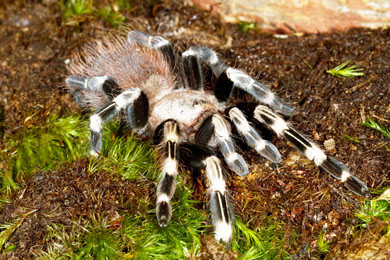RESEARCH ON GOLIATH BIRD EATER SPIDER
SPIDER:

According to a 2012 study out of the University of Buffalo, a particular protein found in spider venom could work as a treatment for muscular dystrophy — an umbrella term for a number of diseases that cause loss of muscle mass and eventual inability to walk, move, or swallow. The study found that the protein helped stop muscle cells from deteriorating, and though it wasn’t a cure, it assisted in slowing down the progression of the disease.
Tarantulas, in particular, have been shown to harbor healing properties in their venom. One 2014 study out of Yale University described a new screening process known as “toxineering” that could sift through millions of spider toxins and find which ones were most compatible in painkiller drugs. They found that one toxin in the Peruvian green velvet tarantula could block chronic pain. Another recent study found that 7 different compounds in spider venom could potentially be used to help people with chronic pain too. Researchers analyzed 206 different spider species, and found that 40 percent of the venoms had compounds that blocked nerve activity linked to chronic pain.
ECOLOGY:
A tarantula’s venom, including that of the Goliath, is usually not lethal to humans, although the Goliath’s bite with its one-inch-long fangs can cause severe pain, nausea, and profuse sweating.

Another serious weapon in a tarantula’s arsenal is its ability to release hairs (actually hairlike setae) from its body at any creature—including a human—it perceives as a threat. The tiny, almost invisible hairs that it voluntarily releases into the air are extremely irritating to skin, and can cause real problems if they get into delicate mucous membranes around eyes or mouth.
The Goliath bird-eating tarantula makes noise—not with vocal cords like dogs, cats, birds, or humans—but by rubbing bristles on its legs together! This hissing noise called stridulation is loud enough to be heard up to 15 feet away.
Tarantulas can be fearsome predators. Unlike some other spiders, they don’t weave intricate webs or leap great distances. Instead, they use stealth and strength to sneak up and pounce on unsuspecting victims, inflicting fatal bites with venomous fangs.
Tarantulas don't have teeth for tearing and chewing their meals. They inject juices into their victims. These juices break down soft tissue so that the spider can slurp up its meal.
Tarantulas eat insects, frogs, small snakes, lizards, and even rodents and bats. The Goliath bird-eating tarantula has been known to catch young birds. This is very rare but the behavior gave the spider its name. Some people in South America eat tarantulas—roasted!
Although fuzzy, tarantulas are not exactly warm, and because of their hair-flinging weaponry, huge fangs, and venom, many people fear them. Others, however, find them good pets.
